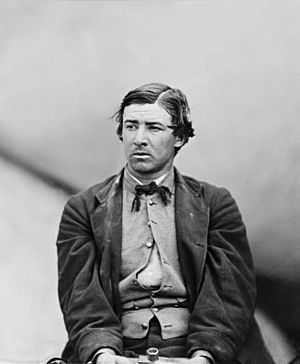David Herold facts for kids
Quick facts for kids
David Herold
|
|
|---|---|

Herold at the Washington Navy Yard after his arrest (1865)
|
|
| Born |
David Edgar Herold
June 16, 1842 Maryland, U.S.
|
| Died | July 7, 1865 (aged 23) Arsenal Penitentiary, Fort McNair, Washington, D.C., U.S.
|
| Cause of death | Execution by hanging |
| Resting place | Congressional Cemetery |
| Occupation | Pharmacist's assistant |
| Criminal status | Executed |
| Parent(s) | Adam and Mary Porter Herold |
| Conviction(s) | Conspiracy to assassinate Abraham Lincoln |
| Criminal penalty | Death |
David Edgar Herold (June 16, 1842 – July 7, 1865) was an American pharmacist's assistant and accomplice of John Wilkes Booth in the assassination of Abraham Lincoln on April 14, 1865. After the shooting, Herold accompanied Booth to the home of Dr. Samuel Mudd, who set Booth's injured leg. The two men then continued their escape through Maryland and into Virginia, and Herold remained with Booth until the authorities cornered them in a barn. Herold surrendered, was tried by a military tribunal, sentenced to death for conspiracy, and hanged with three other conspirators at the Washington Arsenal, now known as Fort Lesley J. McNair.
Biography
Early life
David E. Herold was born in Maryland, the sixth of eleven children of Adam George Herold (1803–1864) and Mary Ann Porter (1810–1883). Adam and Mary were married on November 9, 1828, in Washington, D.C. David was their only son to survive to adulthood. His father Adam was the Chief Clerk of the Naval Storehouse at the Washington Navy Yard for over 20 years. Herold's family was well-off financially and lived in a large brick house at 636 Eighth Street SE in Washington, D.C., near the Washington Navy Yard. David attended Gonzaga College High School, Georgetown College, Charlotte Hall Military Academy (at Charlotte Hall, St. Mary's County, Maryland), and the Rittenhouse Academy. In 1860 Herold received a certificate in pharmacy from Georgetown College. He then worked as a pharmacist's assistant and as a clerk for a doctor and was an avid hunter. He became acquainted with John Surratt while attending Charlotte Hall Military Academy classes in the late 1850s. A few years later, in December 1864, Surratt introduced him to John Wilkes Booth.
Assassination plot
Herold and a group of co-conspirators had originally plotted to kidnap Lincoln, but later decided to kill him, Vice President Andrew Johnson, and Secretary of State William H. Seward in a bid to help the Confederacy's cause.
On the night of April 14, 1865, Herold guided Lewis Powell to Seward's house. Inside, Powell attempted to kill Seward, severely wounding him and other members of his household. The ensuing commotion frightened Herold and he rode off, leaving Powell to fend for himself. Another conspirator, George Atzerodt, was supposed to kill Vice President Andrew Johnson but he did not show up.
Booth shot Lincoln at Ford's Theater. When he jumped onto the stage after shooting Lincoln in the back of the head, he may have broken his fibula. He fled on horseback across the bridge into Maryland, where he met Herold. They headed to Surrattsville, Maryland (now Clinton), where they picked up weapons that Mary Surratt had left earlier for them at her tavern. Booth and Herold went to the home of Dr. Samuel Mudd, who set Booth's leg. Mudd let Booth and Herold rest at his home for a few hours. The pair then headed to the house of Samuel Cox, a Confederate sympathizer. He refused to let the two into his house, and insisted that they stay in a thicket behind the house. He brought food, whiskey, and newspapers to Booth and Herold, which is how Booth realized that he wasn't seen as the hero (like Marcus Junius Brutus) that he longed to be. After a close encounter with the Union, Herold slaughtered the horses that he and Booth rode, worrying they would give the two away. Cox later gave Booth a skiff to cross the Potomac River. Due to the thick fog, Herold and Booth landed in Maryland, not in Virginia, as planned. They next threatened a farmer and forced him and his family to sleep outside, while the assassin and his cohort slept in the bedrooms. They left in the morning and went to a farm owned by Richard Henry Garrett. Unaware of what they had done, Garrett let them stay on his property and made the two sleep in the tobacco barn. Soon, they woke to the sounds of horses.
Herold and Booth were trapped by Union soldiers on April 26. Herold surrendered, but Booth refused to lay down his arms and was shot by Sergeant Boston Corbett. He died a few hours later.
Trial and execution
Herold was tried before a military tribunal. As he had already admitted his involvement in the assassination conspiracy, the only defense his lawyer Frederick Stone could offer was that Herold was feeble-minded and under undue influence from Booth. His defense being unsuccessful, Herold was convicted and sentenced to death. He was hanged in Washington, D.C., on July 7, 1865.
On February 15, 1869, Herold's mother and five of his sisters interred his remains in Congressional Cemetery in Washington, D.C., in an unmarked grave, next to the grave of his father Adam. The gravestone memorializing David in Congressional Cemetery was placed there in July 1917, at the time of the burial of his sister Mary Alice (Herold) Nelson (October 16, 1837 – July 1, 1917) in the cemetery. Mary Alice was the wife of Frederick Massena Nelson (January 1827 – May 11, 1909) of Pomonkey, Charles County, Maryland.


